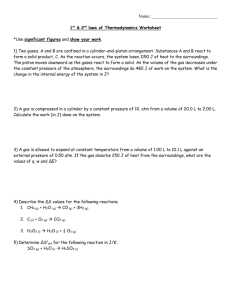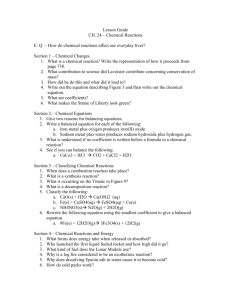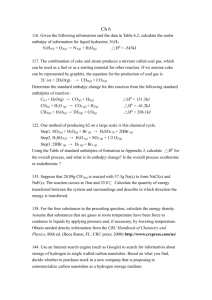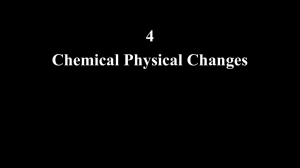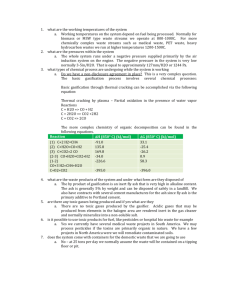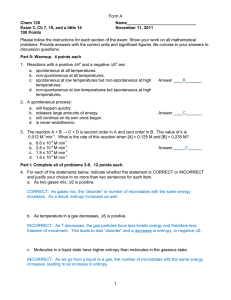Form A Chem 130 Name______________________________
advertisement
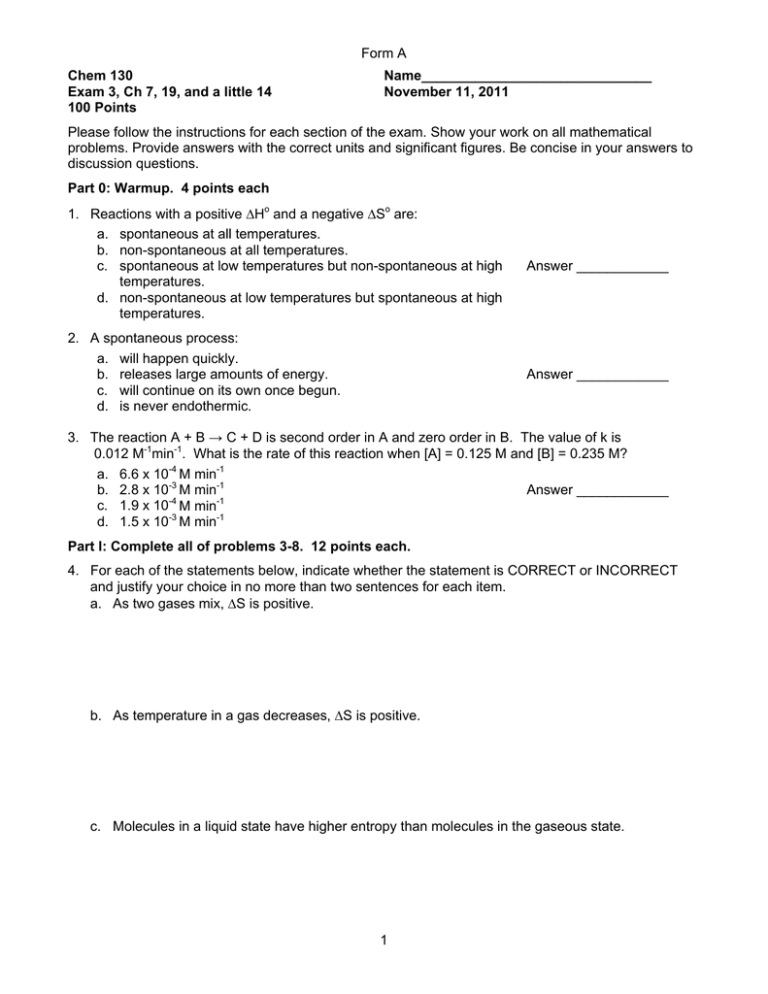
Form A Chem 130 Exam 3, Ch 7, 19, and a little 14 100 Points Name______________________________ November 11, 2011 Please follow the instructions for each section of the exam. Show your work on all mathematical problems. Provide answers with the correct units and significant figures. Be concise in your answers to discussion questions. Part 0: Warmup. 4 points each 1. Reactions with a positive Ho and a negative So are: a. spontaneous at all temperatures. b. non-spontaneous at all temperatures. c. spontaneous at low temperatures but non-spontaneous at high temperatures. d. non-spontaneous at low temperatures but spontaneous at high temperatures. Answer ____________ 2. A spontaneous process: a. will happen quickly. b. releases large amounts of energy. c. will continue on its own once begun. d. is never endothermic. Answer ____________ 3. The reaction A + B → C + D is second order in A and zero order in B. The value of k is 0.012 M-1min-1. What is the rate of this reaction when [A] = 0.125 M and [B] = 0.235 M? a. 6.6 x 10-4 M min-1 b. 2.8 x 10-3 M min-1 Answer ____________ c. 1.9 x 10-4 M min-1 d. 1.5 x 10-3 M min-1 Part I: Complete all of problems 3-8. 12 points each. 4. For each of the statements below, indicate whether the statement is CORRECT or INCORRECT and justify your choice in no more than two sentences for each item. a. As two gases mix, S is positive. b. As temperature in a gas decreases, S is positive. c. Molecules in a liquid state have higher entropy than molecules in the gaseous state. 1 Form A 5. A coffee-cup calorimeter contains 100.0 mL of 0.300 M HCl at 20.3oC. When 1.82 g zinc metal also at 20.3oC is added and is allowed to react, the temperature rises to 30.5oC. What is the heat of reaction per mole of Zn? Assume no heat is lost during the course of the reaction and that the heat capacity and the density of the solution is the same as that of pure water. Zn(s) + 2H+(aq) → Zn2+(aq) + H2(g) 6. Determine Ho for the reaction N2H4(l) + 2H2O2(l) → N2(g) + 4H2O(l) from these data: Reaction N2H4(l) + O2(g) → N2(g) + 2H2O(l) H2(g) + ½ O2(g) → H2O(l) H2(g) + O2(g) → H2O2(l) 2 Ho -622.2 kJ -285.8 kJ -187.8 kJ Form A 7. Determine the standard enthalpy of formation of hexane, C6H14(l), from the information below. Report your result in units of kJ per mole of hexane. 2 C6H14(l) + 19 O2(g) → 12 CO2(g) + 14 H2O(l) Ho = -8326 kJ o -1 -1 Species Hof, kJ mol-1 S f, J mol K Gof, kJ mol-1 O2(g) 0 205.1 0 H2(g) 0 130.7 0 C(s, graphite) 0 5.74 0 CO2(g) -393.5 213.7 -394.4 H2O(l) -285.8 69.91 -237.1 H2O(g) -241.8 188.8 -228.6 8. For the reaction, 2 NO(g) + Cl2(g) → 2 NOCl(g), Ho = -40.9 kJ. At what temperatures do you expect the reaction to be spontaneous: high, low, all, or none? Justify your answer. 3 Form A Part II. Answer two (2) of problems 9-11. Clearly mark the problems you do not want graded. 15 points each. 9. The initial rate of the reaction A + B → C + D is determined for different initial conditions, with the results listed in the table below. Determine the rate law and the rate constant for the reaction. Experiment [A], M [B], M Initial Rate (Ms-1) 1 0.0133 0.0185 3.35 x 10-4 2 0.0133 0.0370 6.75 x 10-4 3 0.0266 0.0370 2.70 x 10-3 4 0.0266 0.0185 1.35 x 10-3 4 Form A 10. Sketch two reaction coordinate diagrams below. For the first diagram, illustrate a generic reaction that is non-spontaneous and fast in the forward direction. For the second, illustrate a generic reaction that is spontaneous and slow in the forward direction. Clearly label your plots. For each diagram, include a brief description of how it satisfies the spontaneity and speed of the reaction requirements. 5 Form A 11. Consider the reaction N2O(g) + 2H2O(l) → NH4NO3(s) at 298K. o -1 -1 Species Hof, kJ mol-1 S f, J mol K Gof, kJ mol-1 O2(g) 0 205.1 0 H2(g) 0 130.7 0 NH4NO3(s) -365.6 151.1 -183.9 N2O(g) 82.05 219.9 104.2 H2O(l) -285.8 69.91 -237.1 H2O(g) -241.8 188.8 -228.6 a. Is the forward reaction exothermic or endothermic? b. What is the value of Go at 298 K? c. Does the reaction occur spontaneously at temperatures above 298 K, below 298 K, both, or neither? Justify your answer. 6 Form A Possibly Useful Information o GH - TS C = K – 273.15 qrxn = nHrxn q = mcT Don’t eat the yellow snow! qreleased = -qabsorbed Compound Molar Mass Compound Molar Mass (g/mol) (g/mol) H2O 18.0153 C6H14 86.177 H2O2 34.0147 CO2 44.010 HCl 36.4606 N2H4 32.0452 H2 2.01588 NH4NO3 80.0434 N2 28.0135 N2O 44.0129 O2 31.9988 NO 30.0061 Cl2 70.9054 NOCl 65.4588 Material Specific Heat Capacity (J/gK) H2O (s) 2.050 H2O (l) 4.184 H2O (g) 2.080 Zn(s) 0.390 7
